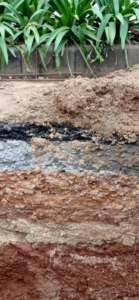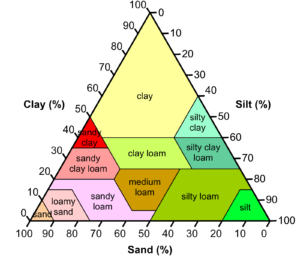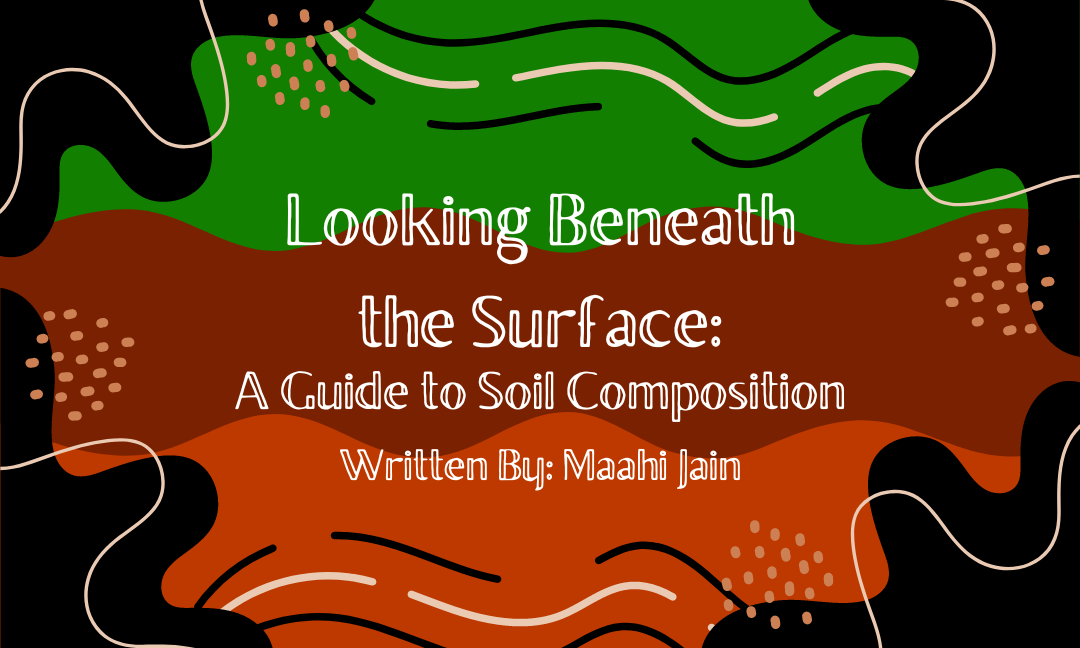Written by: Maahi Jain
Edited by: Consy Sonde
Designed by: Tvisha Lakhani
Published by: Kiritika Rana
We all know what soil is, but what is known the least to people is that it’s a fundamental element to the ecosystem, and also one of the many factors that help lessen the impacts of global warming. Soil is an underrecognized part of Earth and not a lot know just how great its contribution is to creating a livable, and sustainable environment.
Soil is a complex substance, with an even more complex process. Soil, ultimately, comes from various types of rocks—igneous, sedimentary, and metamorphic. Igneous rocks are formed when lava cools down, while sedimentary rocks are formed when small pieces of rock stick together. Metamorphic rocks are formed when the rocks get heated and/or pressed. These rocks gradually break down into smaller particles through the process of weathering, finally turning into soil. Weathering can occur physically, chemically, or biologically:
- Physical (mechanical) – breakdown of rocks as a result of external causes, including temperature change, colliding rocks (abrasion), or frost.
- Chemical – breakdown due to minerals in the rocks reacting with water, air, or other chemical substances.
- Biological – breakdown by animals; creatures form cracks, allowing air and water to seep through
 The characteristics of soil—colour, texture—depend on the five main factors affecting soil formation. These factors are climate, time, topography, living organisms, and parent material. Each process takes tens of thousands of years to complete and are important to creating the soil we know and use today:
The characteristics of soil—colour, texture—depend on the five main factors affecting soil formation. These factors are climate, time, topography, living organisms, and parent material. Each process takes tens of thousands of years to complete and are important to creating the soil we know and use today:
- Climate – different kinds of soil arise from being exposed to different temperatures. Soils form easily when exposed to temperate, or tropical, conditions, and areas with controlled precipitation. Places with excessive water will result in leaching of nutrients, forming acidic soils, whereas regions with humid conditions will create soil mainly with organic matter.
- Time – depending on the time it takes for it to be weathered, soil may form with varying characteristics. According to research, Australia has some of the oldest soils.
- Topography – this refers to the length, surface, and shape of a slope. Slope affects how much rainfall receives.
- Living organisms – small bacteria and insects help to decompose plant and animal matter, increasing soil fertility.
- Parent material – this is what forms the very basis of soil. It is produced from different rocks, going through the tedious process of weathering.
As soil forms, it develops layers—called horizons—each consisting of different minerals and substances. These layers form what’s called a soil profile and help to provide nutrients assisting with plant growth.
- O (organic) – this is the topmost layer and consists of mostly litter and organic matter, usually decomposed plant and animal matter.
- A (topsoil) – it contains the accumulation of humus. This is the darkest layer due to high amounts of organic matter.
- E (eluviated) – a layer that’s been eluviated (leached) of its clay and minerals. This causes it to be sandier and paler in colour compared to other layers.
- B (subsoil) – rich in the minerals that leached from previous soil layers. It is less fertile than other soils, however, it retains more moisture.
- C (parent material) – layer of accumulation of parent material.
- R (bedrock) – the layer of bedrock from which parent material forms.

There are six types of soil—sandy, clay, silt, peat, chalk, and loam. Deciding the type of soil needed for efficient plant growth is just as important as learning to take care of it.
Sandy soil is light in colour and dry, with little to no nutrients. They are able to drain water quickly due to the large spaces between the sand particles. Furthermore, having additional organic matter present will greatly improve its water retention capability.
Clay soil, during winter, is wet and cold, whereas in warmer weather, it remains dry. Clay soils are able to hold high amounts of water because of the large clay particles.
Silt soil is very fertile, and because they’re composed of medium-sized particles, silt soil can hold a fair amount of water.
Peat soil is extremely high in organic matter levels and is very rarely used in gardening. Chalk soil is basic in pH due to high levels of calcium carbonate present.
Finally, loam soil is a soil widely used throughout Canada and is a mixture of sand, silt, and clay soil. This soil is fertile and has good water retention.
Soil is vital, not just in the agriculture and farming industry, but for the ecosystem to thrive as well. It is recommended that thorough research be done to decide which soil will work best for which plant. Taking care of soil is important, as it does almost the same work as trees—providing oxygen, and helping to make communities a livable space.
Works Cited
The History of Soil Science. (n.d.). Rogitex. Retrieved May 26, 2023, from https://rogitex.com/blogs/soil-for-humanity/history-of-soil-science
How soils form | Environment, land and water. (2013, October 8). Queensland Government. Retrieved May 26, 2023, from https://www.qld.gov.au/environment/land/management/soil/soil-explained/forms
Needelman, B. (2013). What Are Soils? Nature Education Knowledge. https://www.nature.com/scitable/knowledge/library/what-are-soils-67647639/#:~:text=Soil%20is%20a%20material%20composed,mineralogy%20of%20soils%20is%20diverse.
Panchuk, K. (n.d.). 5.4 Weathering and the Formation of Soil – Physical Geology. BC Open Textbooks. Retrieved May 26, 2023, from https://opentextbc.ca/geology/chapter/5-4-weathering-and-the-formation-of-soil/
Soil Types. (n.d.). Boughton. Retrieved May 29, 2023, from https://www.boughton.co.uk/products/topsoils/soil-types/
Sposito, G. (2023, May 4). Soil | Definition, Importance, Types, Erosion, Composition, & Facts. Britannica. Retrieved May 26, 2023, from https://www.britannica.com/science/soil
File:Soil Profile 20210710 Hessaraghatta Main Road.jpg. (n.d.). Wikimedia Commons. [Photograph]. Retrieved May 29, 2023, from https://commons.wikimedia.org/wiki/File:Soil_Profile_20210710_Hessaraghatta_Main_Road.jpg
Wheeler, R. (n.d.). File:SoilComposition.png. Wikimedia Commons. [Photograph]. Retrieved May 29, 2023, from https://commons.wikimedia.org/wiki/File:SoilComposition.png

